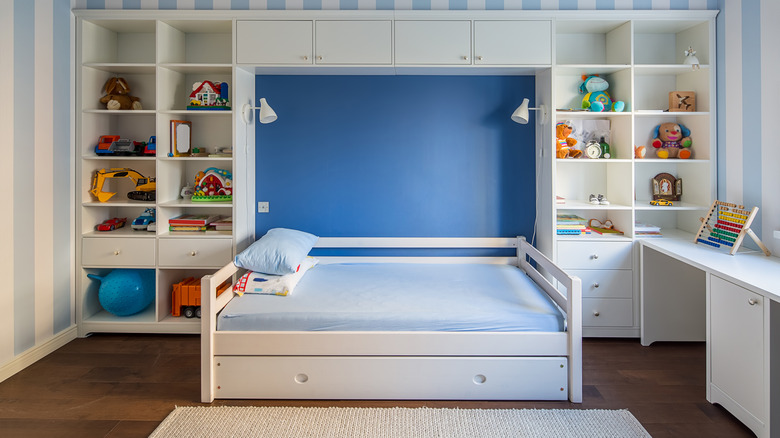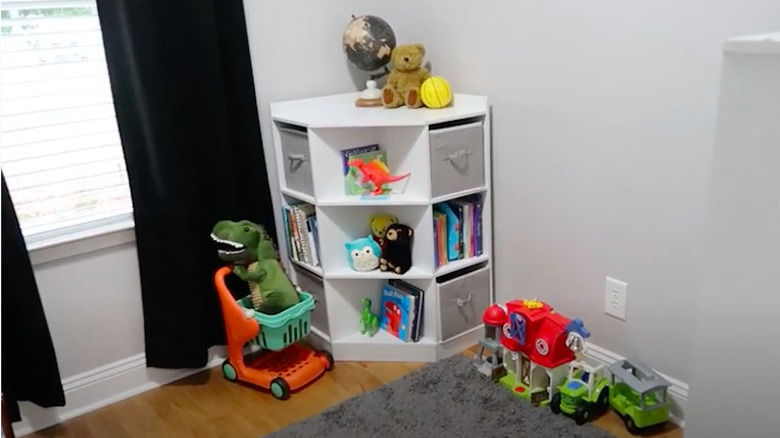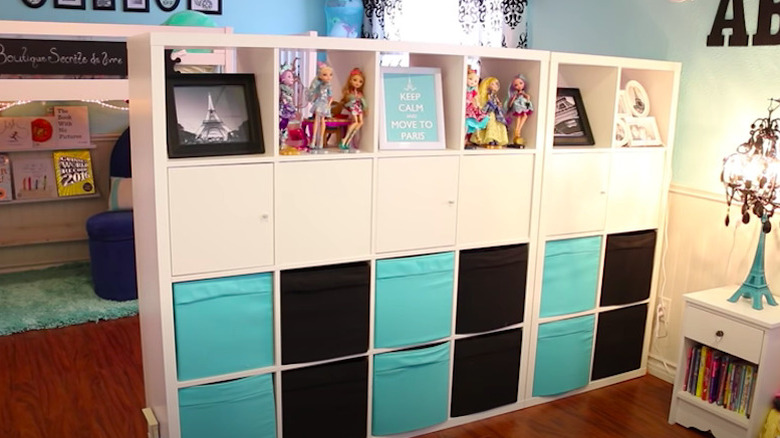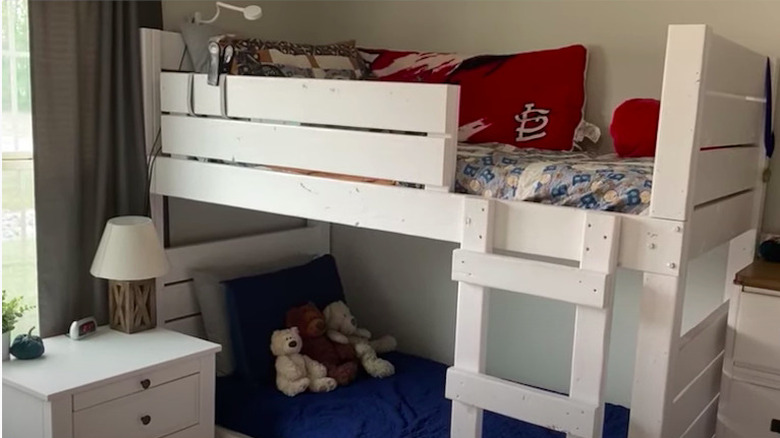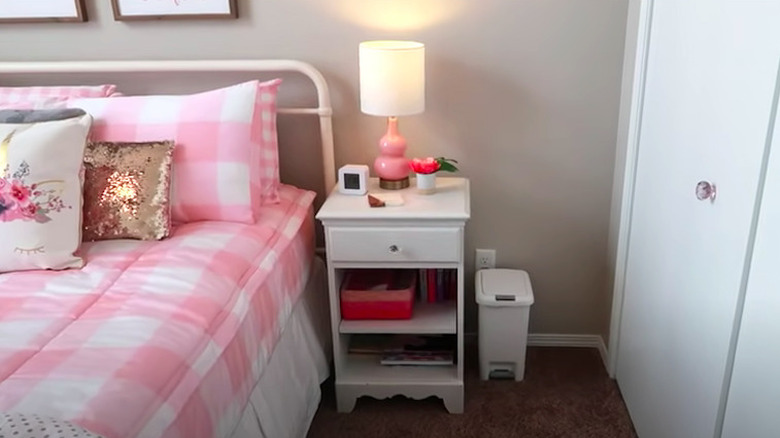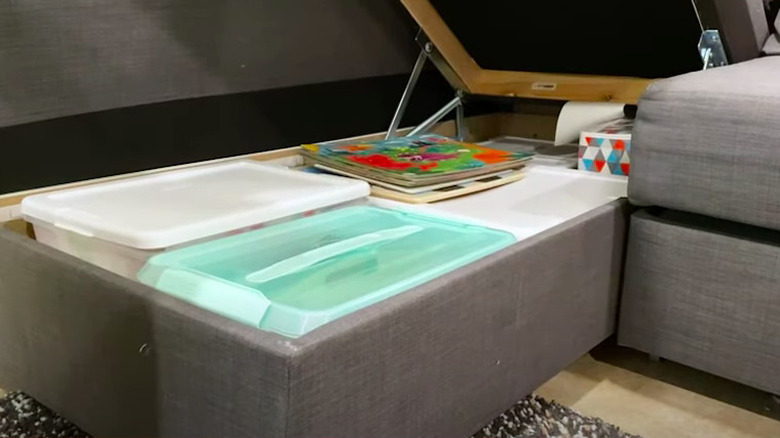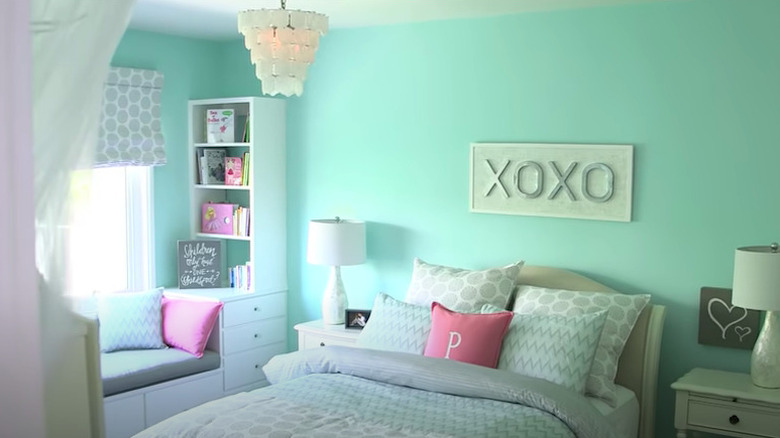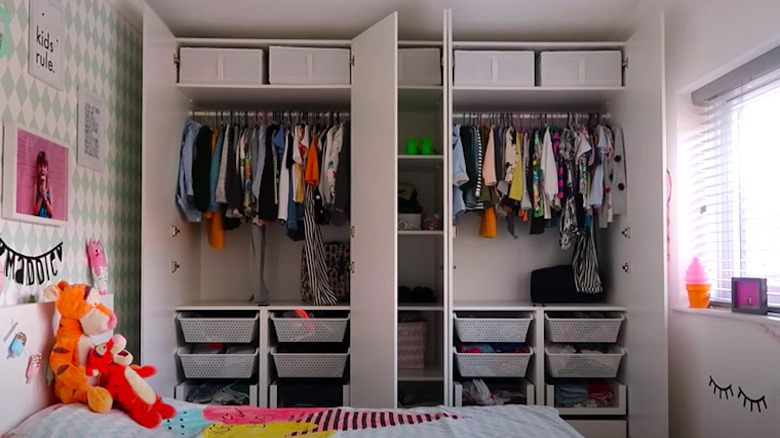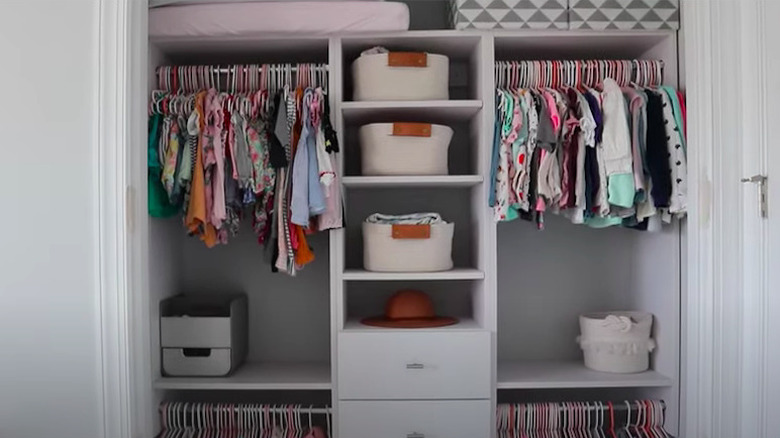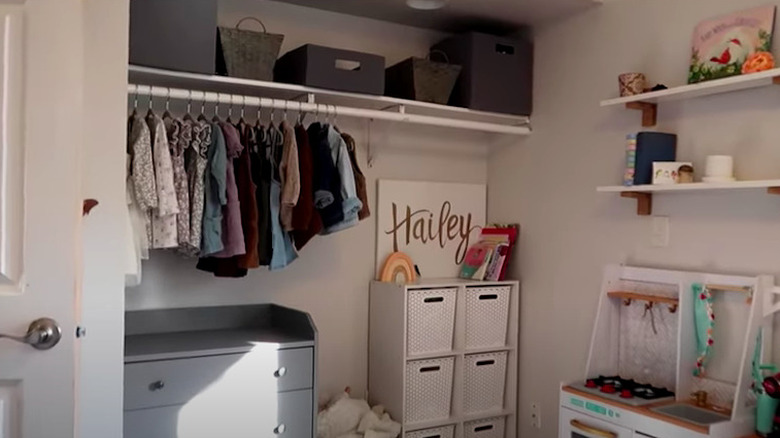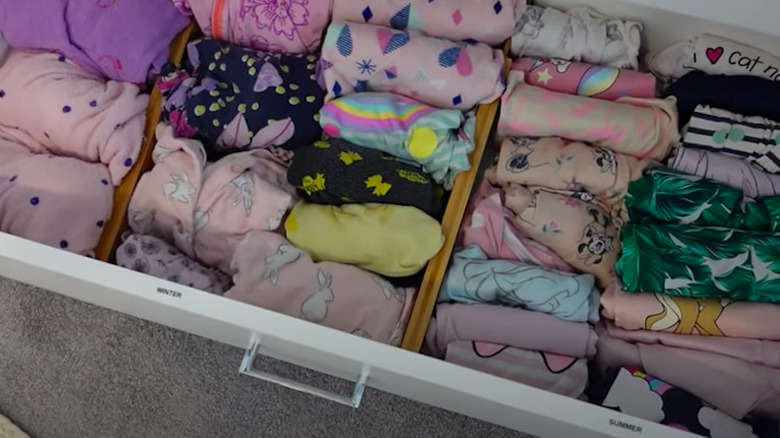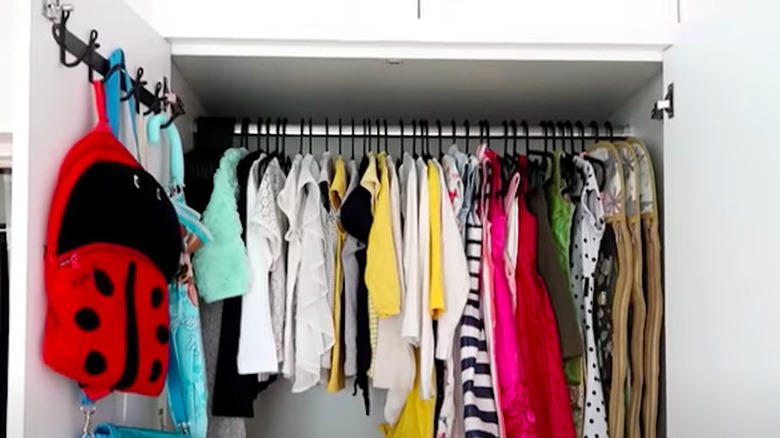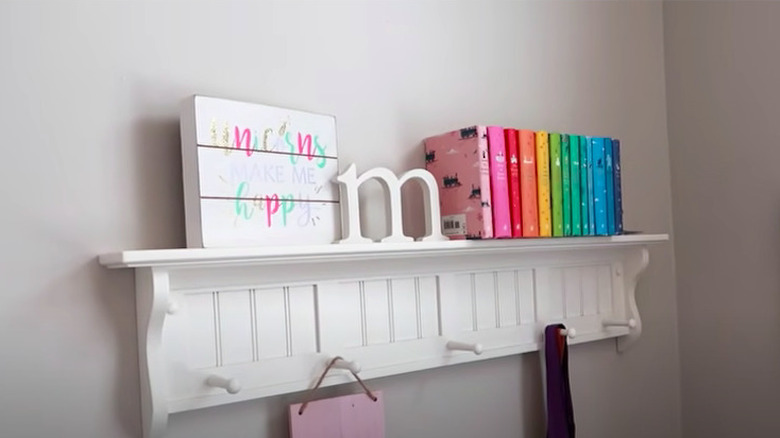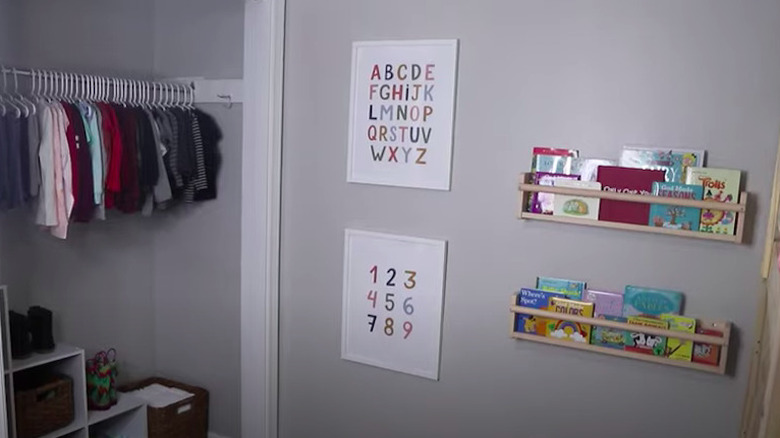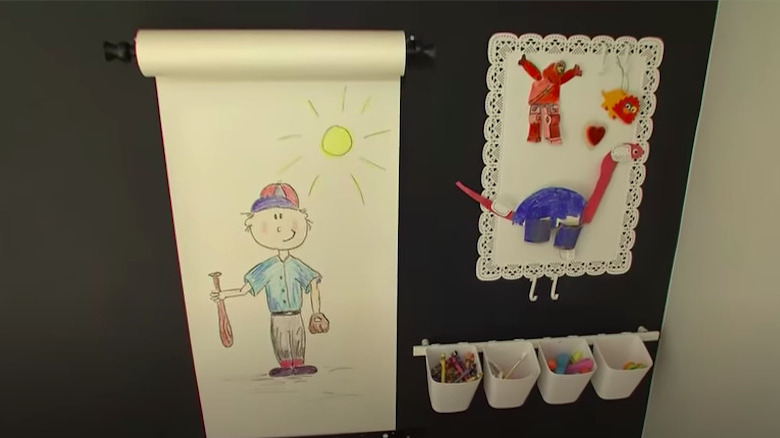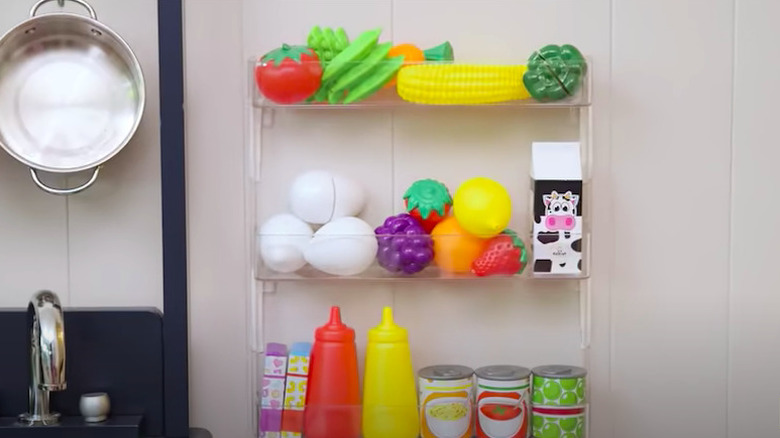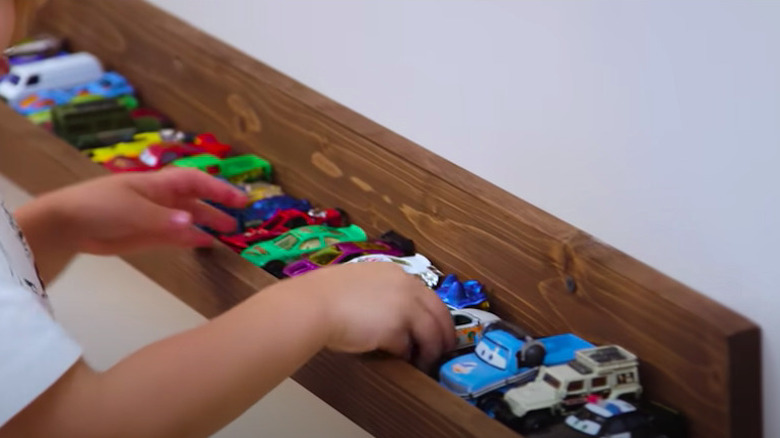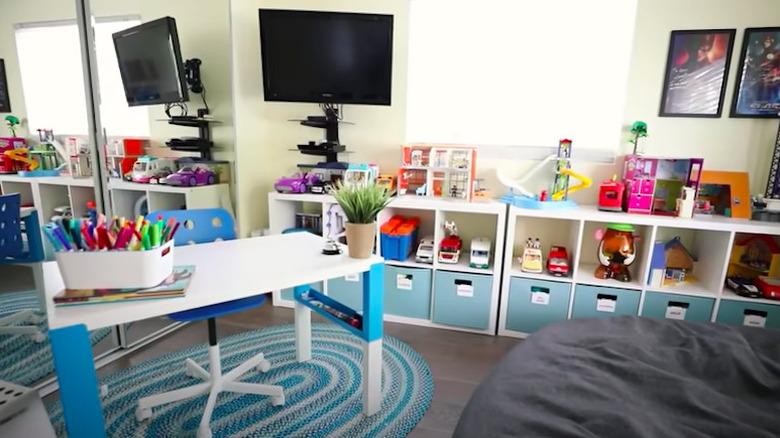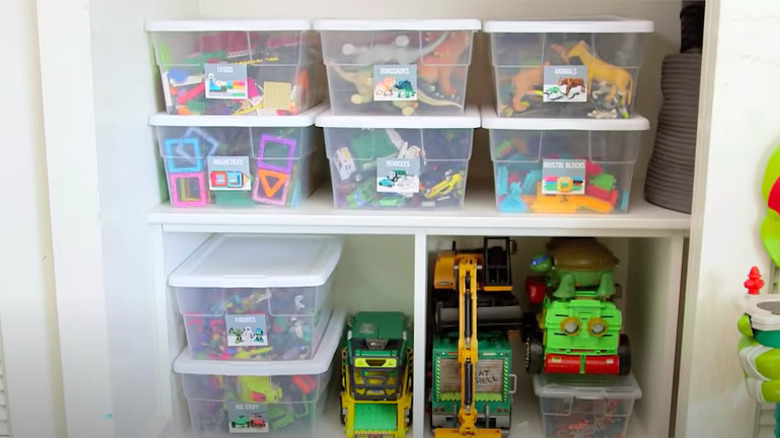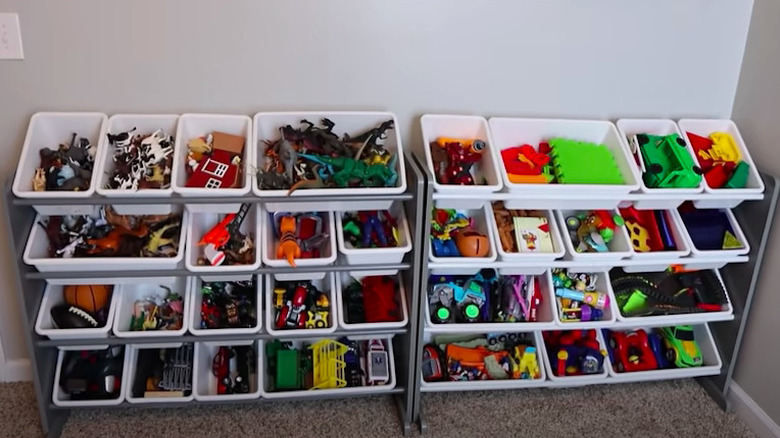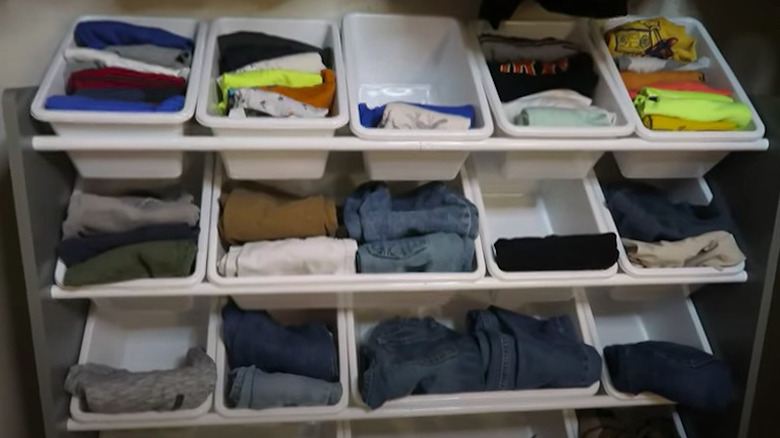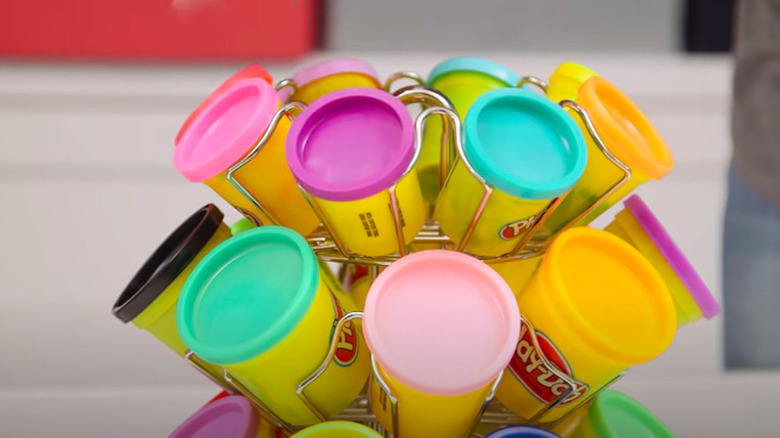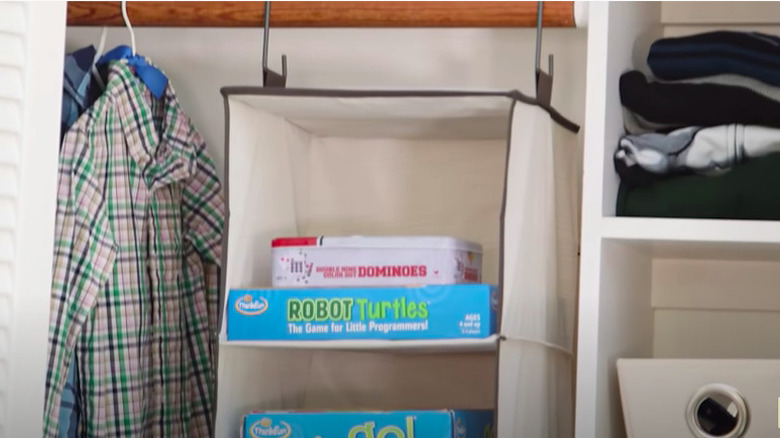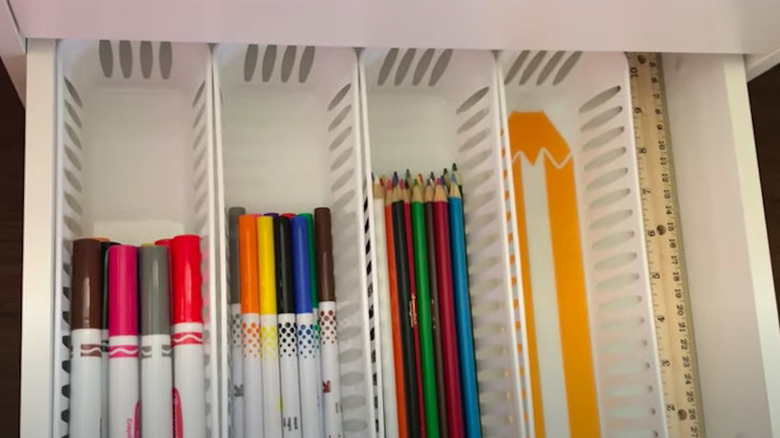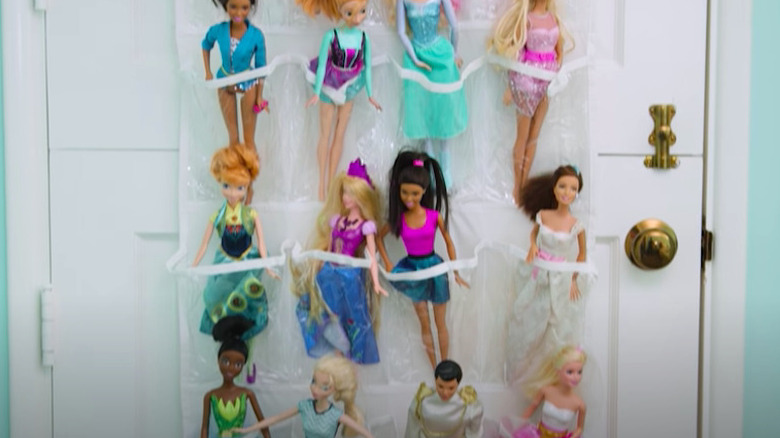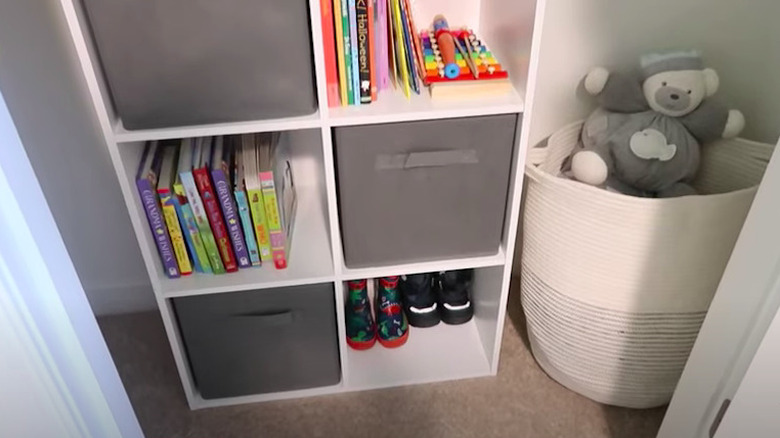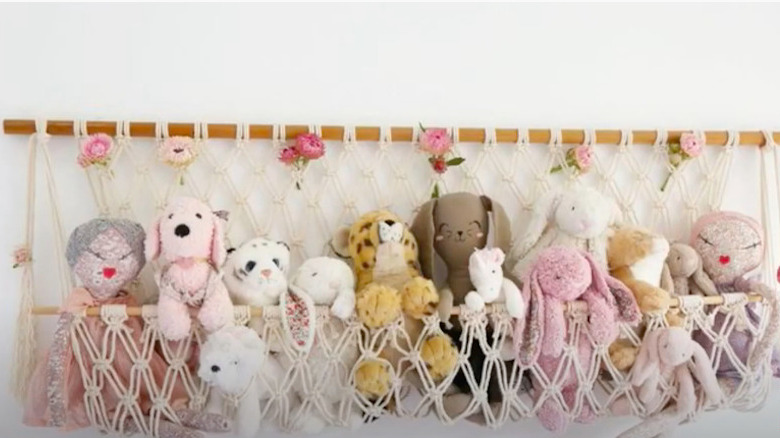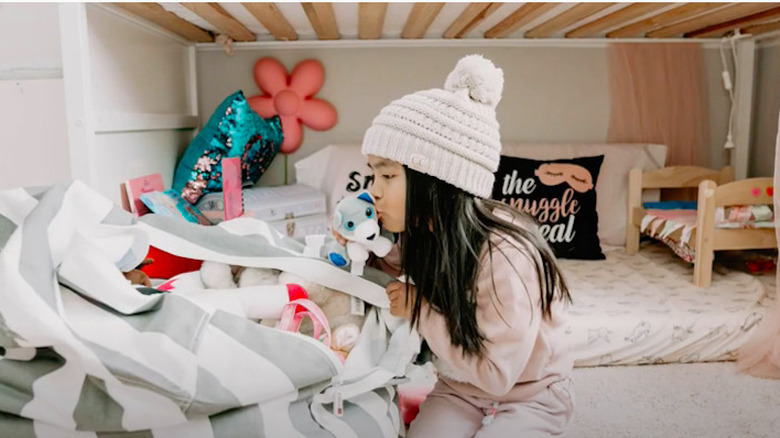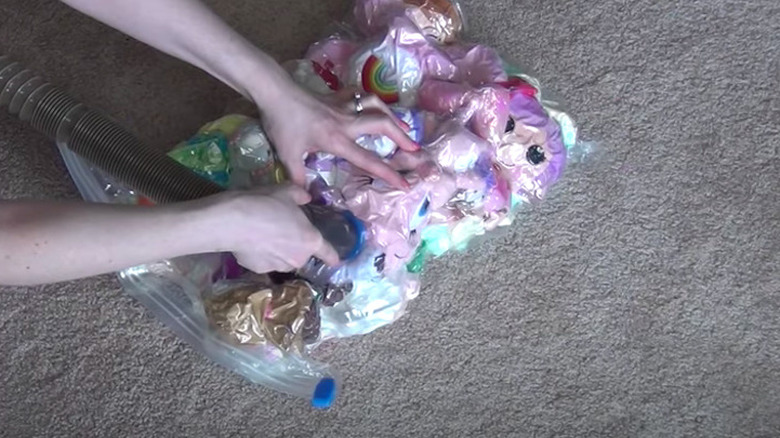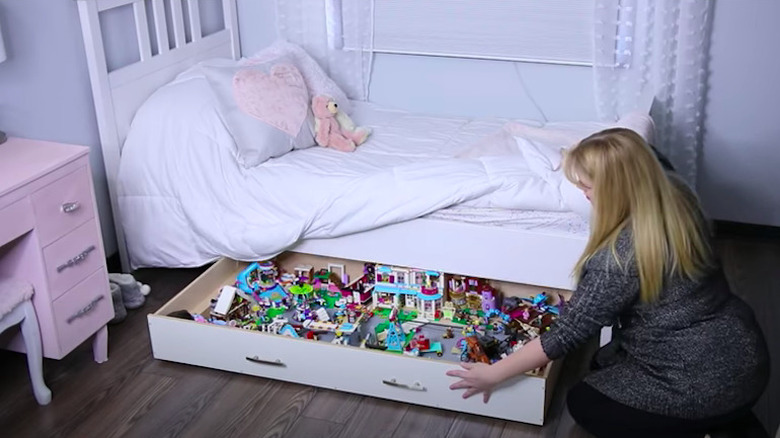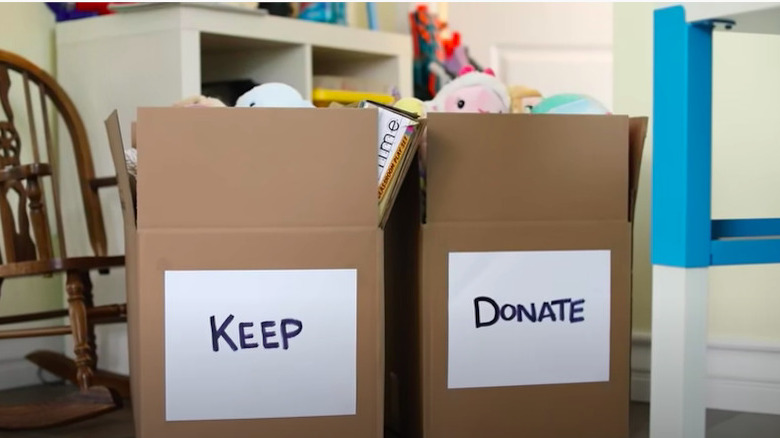30 Ways To Creatively Add More Storage Space In Your Kids' Room
It's no secret that with kids comes a mess. Their toys, clothes, and books seemingly take up a ton of space despite their mostly small shapes and sizes. Finding homes for their things isn't always easy, which then leads to being even more difficult for them to put anything away. Before you know it, kid clutter is spilling out of their bedrooms and piling up in your living room, kitchen, and every other area of the house.
Fortunately, there are plenty of easy solutions to keep the stuff better organized, and that includes adding more storage space in your kids' room. According to The Container Store, in addition to involving them in the process and creating a routine they just might like, using every available space you can is the trick to keeping things tidy. Take a look through these 30 ways you can creatively add extra storage in their rooms and get the chaos under control.
1. Carve out a cubby corner
Cubbies are an excellent storage solution for kids' things as they're usually at the perfect eye level. If wall space is limited, find one that can nestle into a corner to make the most out of that space. Store books, stuffed animals, and miscellaneous items in bins to get things up and off the floor.
2. Put up a partition
A great wall of cubbies can act as a makeshift partition in a kid's room. Either use them to divide up beds for a shared room or create separate zones for sleep and play. It can serve as a mini wall and hold a great deal of clutter, keeping the room neater.
3. Bunk the beds
Another way to save a ton of space in a shared room is to put bunk beds in. Not only does it open up the walkway, but it also gives each child a bit more privacy. Hang their medals off the edge of the top bunk and slide organizers under the bottom for additional storage.
4. Select a side table with storage
Many nightstands on the market look cute but aren't necessarily functional. If you need extra space in your child's room, choose a side table or two that has drawers, open cubbies, or both. They can store some of their most prized possessions right by their bedside.
5. Look for furniture with hiding spots
Multi-purpose furniture is the go-to choice for small spaces. Look for ottomans, sofas, and benches with a lid that can easily lift. Store stuffed animals, board games, and even seasonal clothes inside, and be sure they're soft-closed so little fingers don't get hurt.
6. DIY a combo unit
If you're handy, you can create a three-in-one piece of furniture combining a window seat with storage, drawers, and shelving. This will give your little one a comfy spot to read in while also providing a great deal of additional space to hold books, décor, and even pajamas.
7. Go sky high
Floor-to-ceiling closets will make organizing kids' clothes, shoes, and accessories a lot easier in small rooms. Seasonal or clothing they have yet to grow into can be stored at the very top, while the everyday items can be tucked away at arm's reach.
8. Design a custom closet
Little items need less hanging space but could benefit from more shelving. Take a basic closet with a single rod and have a second one along with custom shelves installed. This allows you to store their tiny shoes, socks, and hats and hang up more clothing. Sort the rods out by size or for no-nonsense organization.
9. Streamline with slimline hangers
Rather stick to the one rod and shelf that came with the closet? Then switch to thin velvet baby or kids hangers to save as much space as possible. You'll be able to fit more clothing in less space if you use slimline ones instead of thicker plastic hangers.
10. File-fold their clothes
To prevent any closet drawers and dressers from being overstuffed with, well, stuff, learn the simple art of file folding. Adopting this folding style for onesies, for example, lets you fit more in the drawers while simultaneously allowing you to see everything you have for your little one. Adding spring-loaded dividers keeps things upright a bit better.
11. Hang some closet door hooks
For any closet with straightforward doors, meaning not bi-fold or sliding, gain some extra storage space by using a few hooks. Either loop them over the door or attach them to the inside and hang your child's backpack, umbrella, and favorite hoodie for easy access.
12. Use some wall hooks
Hooks can be placed anywhere in the kids' room. Just look for a bit of black wall space, perhaps by the entrance to the room, and hang individual ones or a rack of multiples. For even more storage space, look for a rack with a shelf above to hold a set of books.
13. Attach some racks
Speaking of books, consider mounting some racks rather than waste a decent amount of floor space with a bookshelf or two. Two or three individual wall racks can be a secure spot to tuck some light reading away for a rainy day.
14. Create a craft wall
No room for a craft table? Give your mini artist a wall to work with. Use chalk paint on a large section, attach a magnetic roll of craft paper, and organize cups for crayons and chalk.
15. Clear containers for the win
Acrylic organizers are all the rage right now, and they make for kid-friendly ones as well since the material is sturdy and easy to clean. Use adhesive wall-mounted bins to store lightweight items such as play kitchen food so they can easily reach in and pick out what they want to "cook."
16. Put up a picture ledge
While it can most definitely store photo frames in your child's room, a picture ledge can also make a great spot for tiny toys such as cars. Hang one at their eye level so your little one can line their favorites up by color or type.
17. Mount the TV
This might seem inconsequential, but mounting their TV onto the wall can open up precious storage space. Instead of the TV taking up room on top of a dresser or cubby unit, the surface area is now available to store medium to larger-sized toys such as a dollhouse.
18. Stack some shoe bins
You don't want to invest a lot into organizing kids' products since they tend to rough them up. Inexpensive shoe bins are perfect for tiny parts such as blocks or figurines and can easily be stacked to conserve space. Be sure to label them so your child knows exactly where to find what they need.
19. Organize at their eye level
For the little ones, it's helpful to have toys right at their eye line. This instills independence in that they can easily grab what they want on their own and makes it easier for them to tidy up. A low-level rack with a slew of titled bins packs a big storage punch in their room.
20. Find a new home for things
If your child has grown out of the aforementioned toy organizer, consider recycling it for something else, such as their clothing or shoes. They're narrow and shallow enough that they should sit comfortably at the base of their closet and may replace the need for a dresser altogether.
21. Repurpose a kitchen organizer
It's fun to be original when it comes to creating organizational systems. If you don't have any purpose for a pod holder in the kitchen anymore, see if it will work to hold small bottles of playdough. Place it somewhere higher so the little ones have to ask before making a mess.
22. Give new life to an old sweater cubby
Have a hanging clothes organizer that you no longer need? Pop it onto your kid's closet rod and use it to hold bulky yet still light items such as board games and puzzles to save a great deal of space in the room.
23. Reuse desk drawer organizers
They work to keep your home office organized, so why not use them in your child's room as well? If they're at the age that calls for a desk to do homework, insert some drawer organizers to create enough space for all their study supplies.
24. Save that old shoe organizer
Over that old, over-the-door plastic organizer you used to use for your shoes? First, shake it out and repurpose it for your doll collection. Then, hang it over the inside of their bedroom door so you can conceal the clutter from the rest of the house.
25. Recycle a hamper
Hampers aren't just for dirty clothing. If you have an extra or an old one lying around, repurpose it for toy or linen storage in your kid's room. Be sure to sanitize any used ones before adding stuffed animals or blankets.
26. Air out the animals
If your child would rather see or reach for their stuffed animals, use an aesthetically pleasing rope and rod hanger to put them on display. An outstanding space may curb the inclination to collect too many. If they can see their favorites all at once, they may not want to clutter up the room with more.
27. Stuff them into a seat
A stuffed animal bean chair is one of the best ways to conceal the chaos and keep it organized. This is a must-have for a kid's room. These empty fabric chairs simply need to be filled with soft plush toys and zipped up to create a hiding spot and a comfy seat.
28. Seal some away
Most children don't play with all their toys at once, and often, they outgrow some while still having a sentimental attachment. Use vacuum-sealed bags to put some soft toys away. When the air is removed, the items take up little space and can be slid on the very top of a closet shelf until needed again.
29. Slide stuff under the bed
Whether it be the sealed stuffed animals or anything else that doesn't get played with often, use the space under the bed as hidden storage. To make it easier on the kids, or even you, find something such as a bin or drawer with wheels so it easily slides in and out.
30. Declutter regularly
While not necessarily a typical storage hack, going through and donating the kids' toys and clothing will give you and them precious space back in their room. Make it a habit to declutter monthly and, if your child is old enough, get them involved in the process, so they know their things are going to someone less fortunate.

